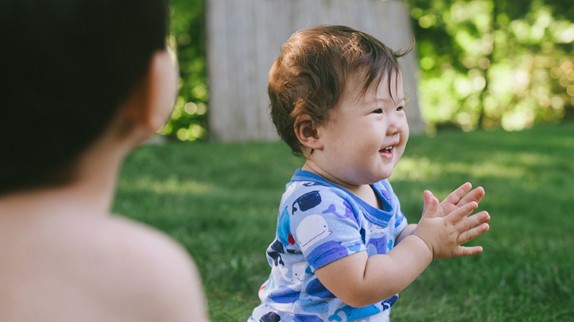Babies start communicating long before they can say a single word. From her first smile to her first laugh, your little one’s nonverbal communication skills are on a fast track from birth, and for good reason: She wants to be understood, especially by you!
As your baby’s motor control develops, she’ll discover that her little hands and fingers can help get your attention. Here’s everything you need to know about these baby gestures.
When should a baby wave, clap and point?
When babies copy the sounds and gestures of others, it’s more than just a cute trick — it’s a sign that they’re learning nonverbal communication skills. It’s the step that comes right before they develop the ability to communicate with words.
- Waving: Somewhere around 9 months, your baby may start to wave. Whether it’s a regal wave or a funny, bird-like flap, this adorable milestone is something to celebrate.
- Clapping: Around the same 9-month mark, your baby may also start to clap, mimicking the gesture in response when you do it.
- Pointing: By 9 months, most babies can point to things that they're interested in — and while that may not seem like a big deal, it definitely is. By pointing, your baby is saying, “Hey! I see something and I want you to see it too!” Experts call this “shared attention” or "joint attention," and it's another developmental milestone.
And your baby won't just point to indicate things that she likes (and wants you to appreciate too) — although that's impressive enough. She’ll also point to indicate actions she wants to make, things she wants, things she remembers and even things that aren't there anymore. Which may explain why she keeps pointing at the tree where she saw a squirrel a few days ago.
Read This Next
How to teach your baby to wave, clap and point
Each child learns these skills at her own pace, but you can help encourage her along with these steps.
- Lead by example. Modeling these actions for your baby is the best way to encourage her nonverbal communication skills. Hold your baby’s hands and bring them together while saying, "Clap, clap, clap." Move her hand in a wave while saying, "Wave bye-bye to Grandpa!" Or, demonstrate to her how you clap your hands yourself or point to something you want. According to one study, when babies watched an adult touch an object with their hand, the hand-related area in their brains was activated. When babies watched an adult touch an object with their foot, the foot-related area in their brains was activated.
- Sing along. Playing musical finger games such as Patty-Cake and This Little Piggy — with your hands helping hers to do the actions while you sing — will also teach your baby the important concept of movement coordinated with meaning.
- Pair objects with words. "Eyes-nose-mouth" is another teaching game that combines action with communication: Take both baby’s hands in yours, touch one to each of your eyes, then both to your nose, then to your mouth (where you end with a kiss), naming each feature as you move along: “eyes, nose, mouth, kiss.”
- Point together. Ask questions like, "Is that a doggy on the sidewalk? Is that a bird in the air?" Put your hand on your baby’s to point her fingers in the same direction to help reinforce how pointing works. Once she sees you pointing at something she remembers and recognizes, she’ll want to point that-a-way, too! When she points at something, you’ll instinctively name it for her, which adds word after word to her vocabulary. Though she won’t repeat these new words quite yet, she’s squirreling them away in her brain to voice later on.
Remember that this is another building block of language development, which lays the foundation for everything from toddler tantrums to teenage heart-to-hearts. It’s also another sign of your baby’s growing relationship with the world around her — she’s learning that you are a separate (but oh-so-important!) person in her life. So marvel at those busy baby hands!
When to talk to your doctor
By 9 to 12 months, most babies are able to clap, wave and point — though if your munchkin hasn’t mastered these skills yet, that’s not necessarily a cause for concern.
Your pediatrician will likely ask about your baby’s nonverbal communication skills by the 1-year well visit. If she’s not waving, clapping or pointing at that time — and she’s not showing signs of any other developmental delays — your doctor may check her again at the 15-month visit.
If you’re concerned about your baby’s development — for example, you have a gut feeling that something’s awry, or a formerly mastered skill has disappeared — talk to your pediatrician. You know your baby best, and addressing any potential developmental issues (such as by taking advantage of services like early intervention) will set her up for the best chance of success.
In the meantime, keep practicing clapping, waving and pointing together, and your baby should get there on her own timeline.
As for what's next? Once your baby masters milestones like waving, clapping and pointing, she’ll start using these gestures in more complex ways to get what she wants. She may point at things for you to name, grab toys to play with, wave when saying goodbye or clap to get you to clap along with her.
As her curiosity increases, you can also start teaching her new things, like pointing to body parts, or following simple verbal commands paired with gestures. Seize the opportunity to introduce her to the verbal companions to their actions.
Remember — right now, your baby’s mental vocabulary is far more advanced than her speaking vocabulary, so provide lots of opportunities for her vocabulary to grow by communicating with her.




 Trending On What to Expect
Trending On What to Expect






